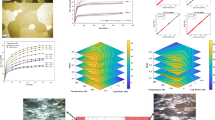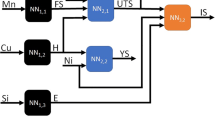Abstract
In this study, a data-driven multilayer perceptron-based neural network model has been developed to predict the percentage of total porosity and mechanical properties, namely yield strength, ultimate tensile strength and percentage of elongation during the solidification of A356 aluminum alloy. Some of the important processing parameters such as cooling rate, solidus velocity, thermal gradient and initial hydrogen content have been considered as inputs to this model. The network training architecture has been optimized using the gradient-based Broyden–Fletcher–Goldfarb–Shanno training algorithm to minimize the network training error within few training cycles. Parametric sensitivity analysis is carried out to characterize the influence of processing parameters (inputs) on the behavior of porosity formation and simultaneously, the tensile properties of A356 alloy castings. It has been observed that initial hydrogen content in the melt and cooling rate has significant influence on the porosity formation and eventually on the tensile properties of the cast product. There has been an excellent agreement between artificial neural network predictions and the target (measured) values of porosity and the tensile properties as depicted by the regression fit between these values.















Similar content being viewed by others
References
Eady JA, Smith DM (1986) The effect of porosity on the tensile properties of Al-alloy castings. Mater Forum 9:217–223
Couper MJ, Nelson AE, Griffiths JR (1990) Casting defects and the fatigue behavior of Al casting alloy. Fatigue Fract Eng Mater Struct 13:213–227
Lee PD, Major JF, Hofmann L (1991) Solidification model validation for an aluminum alloy cylinder. In: Numerical simulation of casting solidification in automotive applications. TMS, pp 231–251
Hofman L, Hloch H, Lee PD (1990) Mathematical modeling of the semi permanent mould casting of aluminum alloy cylinder heads and engine blocks. SAE Int Congr Expo 900657:177–184
Walther WD, Adams CM, Taylor HF (1956) Mechanism for pore formation in solidifying metals. AFS Trans 64:658–664
Piwonka TS, Flemings MC (1966) Pore formation in solidification. Trans Metall Soc AIME 236:1157–1165
Kimio K, Pehlke RD (1985) Mathematical modeling of porosity formation in solidification. RD Metall Trans 16B:359–366
Lee PD, Chirazi A, See D (2001) Modeling micro porosity in aluminum alloys: a review. J Light Met 1:15–30
Lee CD (2007) Effects of microporosity on tensile properties of A356 aluminum alloy. Mater Sci Eng A 464:249–254
Perzyk M, Kochanski A (2003) Detection of causes of casting defects assisted by artificial neural network. Proc Inst Mech Eng Part B J. Eng Manuf 217:1279–1284
Dobrzański LA, Mariusz K, Jerry S, Piotr Z (2007) The use of neural networks for the classification of casting defect. Int J Comput Mater Sci Surf Eng 1:18–27
Shafyei A, Anijdan SHM, Bahrami A (2006) Prediction of porosity percent in Al–Si casting alloys using ANN. Mater Sci Eng A 431:206–210
Anijdan SHM, Bahrami A, Hosseini HRM, Shafyei A (2006) Using genetic algorithm and artificial neural network analyses to design an Al–Si casting alloy of minimum porosity. Mater Des 27:605–609
Srinivasulu RK, Ranga JG (2009) Developing a neuro fuzzy model to predict the properties of AlSi12 alloy. ARPN J Eng Appl Sci 4:63–73
Ostad M, Ali M (2011) The ANN application in FEM modeling of mechanical properties of Al–Si alloy. Appl Math Model 35:5707–5713
Shabani MO, Alizadeh M, Mazahery A (2011) Modeling of mechanical properties of cast A356 alloy. Fatigue Fract Eng Mater Struct 34:1035–1040
Shabani MO, Mazahery A (2011) Application of finite element method for simulation of mechanical properties in A356 alloy. Int J Appl Math Mech 7:89–97
Matthies H, Strang G (1979) The solution of non linear finite element equations. Int J Numer Methods Eng 14:1613–1626
Nocedal J (1980) Updating quasi-Newton matrices with limited storage. Math Comput 35:773–782
Dennis JE, Schnabel RB (1983) Numerical methods for unconstrained optimization and nonlinear equations. Prentice-Hall, Englewood Cliffs, NJ
Carlson KD, Zhiping L, Christoph B (2007) Modeling the effect of finite-rate hydrogen diffusion on porosity formation in aluminum alloys. Metall Mater Trans 38B:541–555
Lee PD, Hunt JD (2001) Hydrogen porosity in directionally solidified aluminum–copper alloys: a mathematical model. Acta Mater 49:1383–1398
Lee YW, Chang E, Chieu CF (1990) Modeling of feeding behavior of solidifying Al-7Si-0.3 Mg alloy plate casting. Metall Trans 21B:715–722
Lee PD, Hunt JD (1997) Measuring the nucleation of hydrogen porosity during the solidification of aluminum–copper alloys. Scr Mater 36:399–404
Hiromi N (2001) Prediction of porosity contents and examination of porosity formation in Al-4.4% Mg DC slab. Sci Technol Adv Mater 2:49–57
Carlson KD, Lin Z, Beckermann C, Mazurkevich G, Schneider MC (2006) Modeling of porosity formation in Aluminum alloys. In: Charles AG, Bellet M (eds) Modeling of Casting, Welding and Advanced Solidification Processes-XI, TMS. The Minerals, Metals and Materials Society, pp 627–634
Samuel AM, Samuel FH (1992) Various aspects involved in the production of low hydrogen aluminum castings. J Mater Sci 27:6533–6563
Author information
Authors and Affiliations
Corresponding author
Rights and permissions
About this article
Cite this article
Ghosh, I., Das, S.K. & Chakraborty, N. An artificial neural network model to characterize porosity defects during solidification of A356 aluminum alloy. Neural Comput & Applic 25, 653–662 (2014). https://doi.org/10.1007/s00521-013-1532-6
Received:
Accepted:
Published:
Issue Date:
DOI: https://doi.org/10.1007/s00521-013-1532-6




